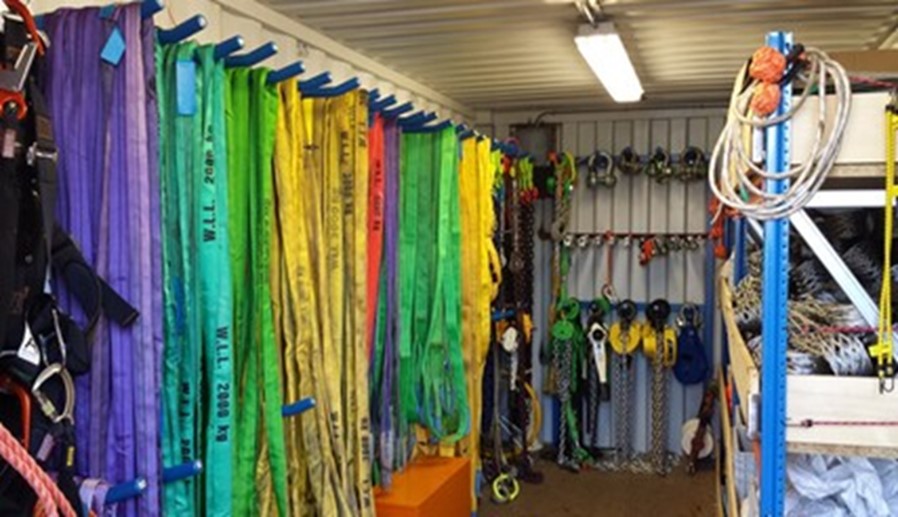
A rigging loft is a secure and portable container or dedicated specific storage area which contains a selection of certified loose lifting equipment, for use in lifting operations either onshore or on an offshore installation or similar work site.
The rigging loft controller should have sufficient knowledge and skills to examine and identify defective lifting equipment and should be responsible for withdrawing it from service, placing it in quarantine to prevent further use and maintaining the records appropriately.
The rigging loft controller should have rigging loft management training emphasizing on rigging loft register keeping, rigging gear inspection, managing unreturned equipment, etc.
Basic Functions of Rigging Loft
The basic functions of the rigging loft is to ensure that portable lifting equipment and lifting accessories are:
1. stored to reduce the risk of accidental damage and to slow down deterioration;
2. effectively controlled so as to prevent unauthorised use;
3. given pre use checks prior to use;
4. removed from service when their condition has deteriorated such that they are no longer in good repair and quarantined.
Requirements for a Rigging Loft
The rigging loft should meet the following requirements:
- Be placed in area, which provides a suitable degree of protection from adverse environmental conditions and work activities.
- Be weather tight, well lit and with suitable air conditioning, if applicable.
- Be of an adequate size with suitable storage compartments/racks.
- Contain work area/desk.
- Contain a quarantine area for equipment. If located outside the loft, it should be secured.
- Be secured against unauthorized use.
- Allow good access and egress.
- Display the current colour code, preferably at the entrance of the loft.
- Be used to facilitate pre and post use inspections and to periodically monitor and control non-returned equipment.
- Contain a secure storage area for controlled items such as webbing slings.
- Contain loft control and equipment inspection procedures.
- Contain a copy of loft equipment certification.
- Contain a register or inventory of all equipment stored in the loft.
- Contain an equipment issuing and return register.
Register and Certification of Lifting Slings
A register of all lifting slings should be kept and maintained and updated by the rigging loft controller for all items in storage or in service. The register should be available for reference and audit as and when required at the rigging loft location.
The register shall contain the following information:
- Copy certificates of test/certification from manufacturer/supplier of all supplied lifting slings.
- Unique identification number.
- Date of manufacture/first test.
- Safe Working Load (SWL) and proof load applied.
- Date of last inspection and interval of examination.
In addition to the above an electronic register should be created and maintained for the control and tracking of each piece of lifting slings at its designated installation/operation area. This should be updated at regular intervals. The register at the rigging loft can be a printed copy of the electronic register.
This register shall be used by the 3rd Party Inspection Contractor when carrying out the 6 monthly inspections of the rigging loft contents and shall be updated by the inspection/certification contractor upon the completion of the 6 monthly inspections.
Issue and Return of Lifting Slings
Each item of lifting slings, prior to issue or return, should be examined by the appointed rigging loft controller for any damage, correct and appropriate markings, safe working load etc. The documentation for each item should also be reviewed, and checked against the actual item.
Equipment found to be in an acceptable, satisfactory condition with the correct and appropriate documentation or markings should be released for use. This shall then be recorded in the Issue and Return Register and detail to whom equipment issued, date of issue/return, type and quantity of equipment, equipment identification number and any other relevant comments. The user shall then sign the register confirming that they have received/returned item.
Tips for Storing Lifting Slings
Textile Slings (Webbing Slings and Round Slings)
- Never return wet, damaged or contaminated slings to storage.
2. They should be cleaned with clear water and dried naturally.
3. Never force dry belt slings.
4. Store belt slings hung from non-rusting pegs which allow the free circulation of air.
5. The storage area should be dry, clean, free of any contaminates and shaded from direct sunlight.
6. Always store your synthetic round slings away from heat sources.
7. Ensure the sling is completely dry before placing it in storage.
Wire Rope Slings
- Never return damaged or contaminated wire rope slings to storage.
2. They should be dry, clean and protected from corrosion.
3. Store wire rope slings on a rack and not lying on the ground.
4. The storage area should be dry and free of any contaminates which may harm the sling.
5. Keep wire rope slings well lubricated by using non-acidic lubricants.
Chain Slings
- Never return damaged or contaminated slings to storage.
2. They should be dry, clean and protected from corrosion and heat sources
3. Store chain slings on a rack and not lying on the ground.
4. The storage area should be dry, clean and free of any contaminates which may harm the sling.
Rigging loft operation ensures the safe use and storage of lifting equipment and accessories as poor storage can have effect on their integrity.
To ensure your lifting equipment is safely use, managed and controlled, contact us for our rigging loft management and safe use of lifting equipment trainings.
Call us on: +234 9115687051. Email: info@primeliftsafetyng.com










